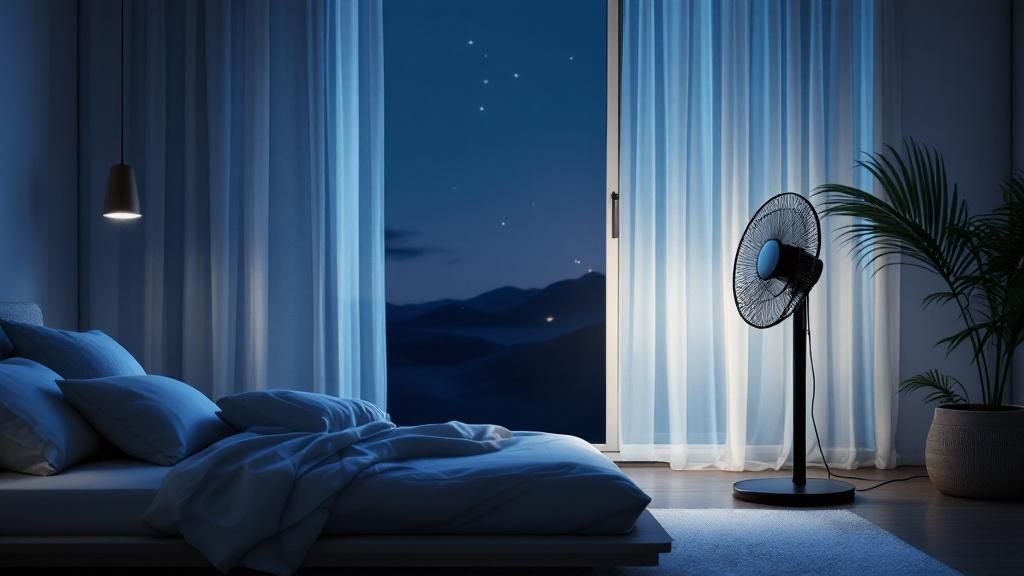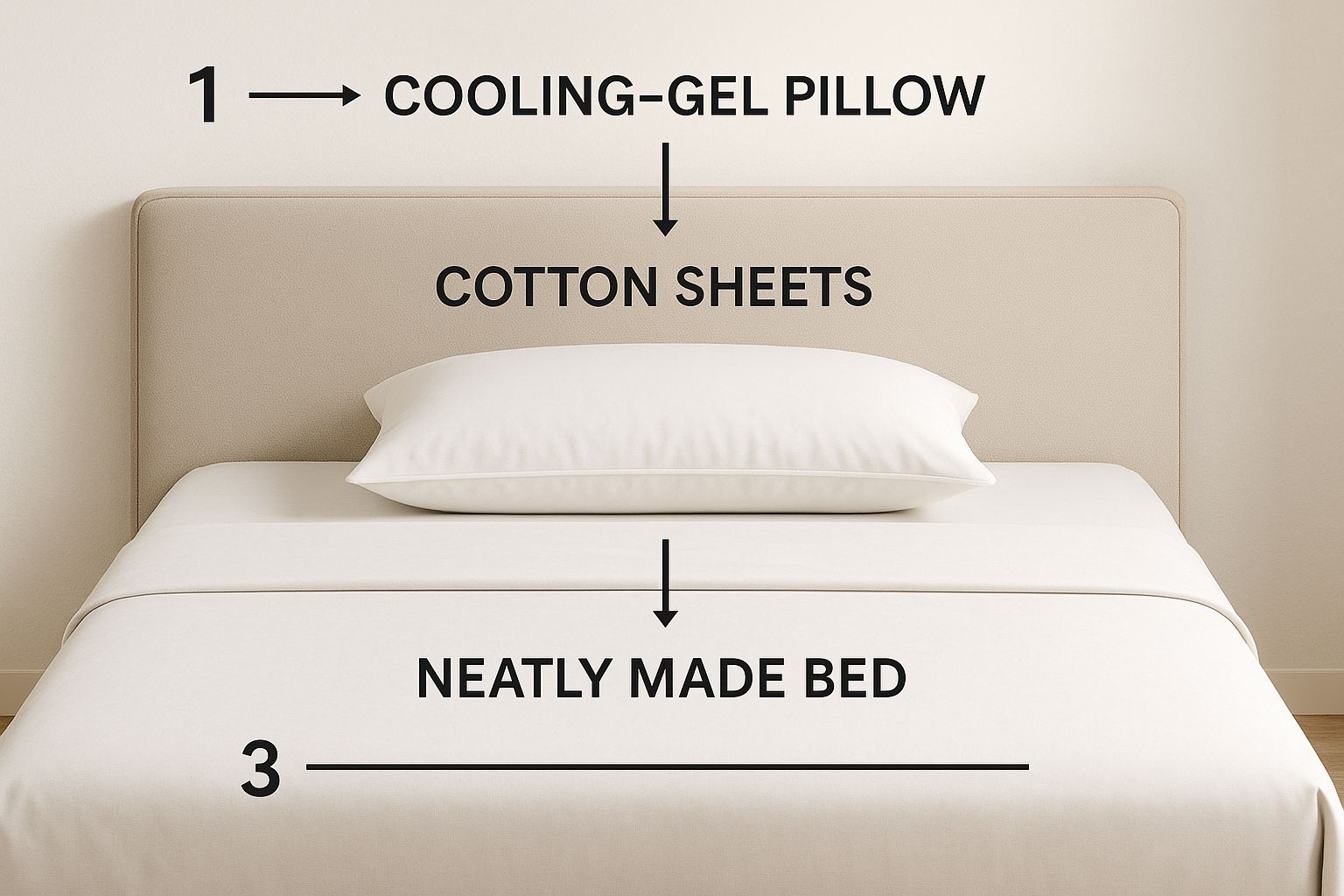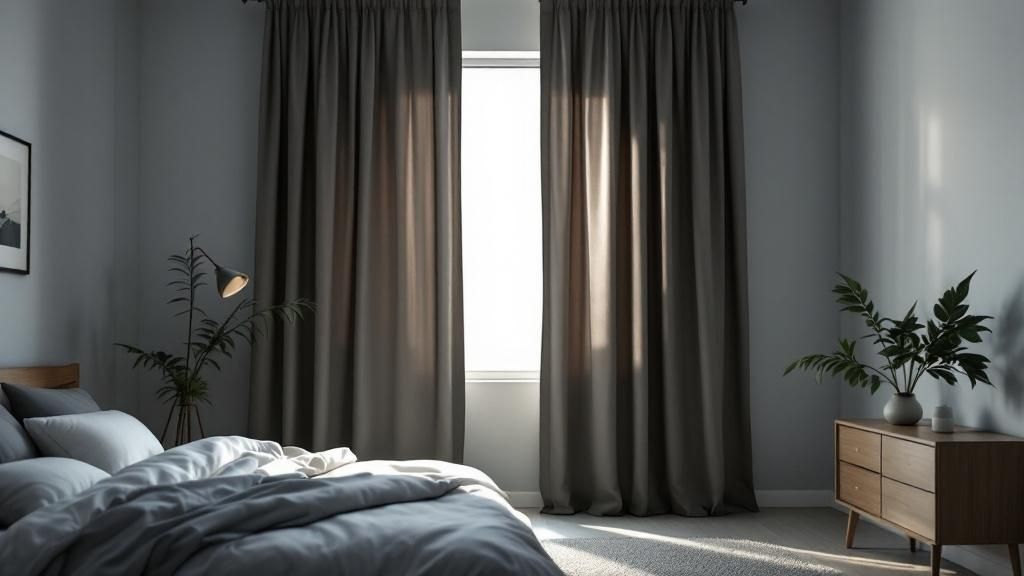Ever find yourself tossing and turning on a warm night? It’s more than just a frustrating experience; it's a clear signal from your body that your environment is disrupting the restorative sleep you need. To truly keep your bedroom cool, the goal is twofold: lower your body's core temperature and cut down on the ambient heat in the room. This isn't just about comfort—it's about working with your body's natural biology.
Why a Cool Bedroom Is Your Best Friend for Sleep

There’s a scientific reason a cool room feels so incredible when you’re trying to sleep. Our bodies are hardwired to associate a drop in temperature with winding down for the night. To kickstart and maintain deep, restorative sleep, your core body temperature actually needs to dip by a few degrees as part of its natural circadian rhythm.
When your bedroom is too warm, you’re essentially fighting against your own biology. Instead of relaxing, your body is forced to work overtime trying to cool itself down. This often leads to that familiar feeling of restlessness, frequent wake-ups, and the dreaded night sweats. This is especially challenging for anyone going through hormonal changes, like menopause, where hot flashes can make a stuffy room feel completely unbearable.
Sleep experts consistently point to an ideal bedroom temperature between 15.6 and 19.4°C (60 to 67°F). This specific range helps your body’s natural thermoregulation process, making it much easier to fall asleep and stay asleep through the night.
Getting your room into this sweet spot is about more than just blasting the air conditioning, though. It’s about being smart and creating a consistently comfortable space with a few practical strategies. We'll walk through some actionable tips that tackle the real sources of a hot bedroom, from blocking out daytime heat to picking the right bedding.
You'll get the hang of how to:
- Effectively block the sun’s heat during the day.
- Choose fabrics and materials that actually breathe.
- Use simple, low-tech tricks for immediate cooling relief.
Mastering Airflow and Windows for a Cooler Night
Before you even think about touching the thermostat, let's talk about airflow. Getting this right can dramatically change how cool your bedroom feels at night. It's not just about cracking a window open; it's about creating a smart, deliberate path for air to move—pushing hot air out and pulling cool air in.
The right environment is a huge piece of the puzzle, and that includes more than just airflow. The materials you sleep on play a big part, too.

As you can see, creating a cool sleep sanctuary starts with breathable materials, which work hand-in-hand with good ventilation to keep you comfortable.
Create a Powerful Cross-Breeze
One of the most effective tricks in the book is creating cross-ventilation. The basic idea is to open windows on opposite sides of your room, which creates a natural corridor for a breeze to flow through. If you only have windows on one wall, don't worry. Just open your bedroom door and a window in another room to get a similar effect.
This isn't just an old wives' tale; the science backs it up. Effective cross-ventilation can actually drop the indoor temperature by 4-6°C (7-11°F) on a warm night. That's a huge difference in comfort, all without touching your AC.
Flush Out the Heat at Night
Here’s a technique I swear by: the "night air flush." As soon as the sun goes down and you feel the outdoor air become cooler than your indoor air, throw those windows open. Let the cool night air completely flood your space for several hours. Then, right before the sun comes up, shut everything tight to trap all that refreshing, cool air inside for the day ahead.
My Favorite Trick: Turn a box fan around so it faces out of your window. Instead of just circulating warm air, this setup actively pushes the hot, stagnant air from your room. This creates a low-pressure zone that pulls cooler air in much more effectively through your other open windows. It’s a total game-changer.
Finally, remember that what you do during the day sets you up for success at night. Keep your blinds and curtains drawn, especially on any windows facing south or west. This simple step blocks a surprising amount of solar heat. Over the long term, if you find your home is consistently too warm, it might be worth looking into an upgrade to energy-efficient windows to really keep the heat out for good.
Choosing Bedding and Sleepwear That Breathes

The fabrics you sleep on and in have a huge say in how well your body manages its temperature overnight. If you're constantly fighting the heat, your bedding might be the real culprit. Dense, synthetic materials like polyester are notorious for trapping body heat and moisture, essentially creating a personal sauna under the covers.
To stay cool, you need materials that work with your body. That means prioritizing natural, breathable fabrics that let air flow freely and pull sweat away from your skin. It’s a simple switch that makes a world of difference.
The Best Fabrics for Cool Sleep
Your sheets are your first line of defense against nighttime heat. Some materials are simply built better for keeping you cool, and investing in a good set is one of the best moves a hot sleeper can make.
- Linen: A timeless choice for a reason. Linen is incredibly breathable and has this wonderful quality of getting softer and more comfortable with every wash. Its slightly textured, airy feel keeps it from clinging to your skin.
- Percale Cotton: If you love that crisp, cool-to-the-touch feeling of hotel sheets, you’ll love percale. Its tight, flat weave is what gives it that signature refreshing quality.
- Bamboo Viscose: This fabric is exceptionally soft and silky, but its real superpower is its ability to regulate temperature and wick away moisture. For a deep dive, check out our guide on why bamboo sheets are an eco-friendly choice for hot sleepers.
A Guide to the Best Cooling Bedding Materials
With so many options on the market, it can be tough to know which fabric is right for you. This quick comparison table breaks down the most common bedding materials to help you see how they stack up for a warm bedroom.
| Fabric Type | Breathability | Moisture-Wicking | Best For |
|---|---|---|---|
| Linen | Excellent | Good | Those who love a natural, airy texture and want maximum airflow. |
| Percale Cotton | Very Good | Good | Sleepers who prefer a crisp, cool-to-the-touch feel. |
| Bamboo Viscose | Excellent | Excellent | Hot sleepers who prioritize silky softness and superior sweat absorption. |
| Tencel™ Lyocell | Excellent | Excellent | Eco-conscious buyers wanting an incredibly smooth, cool, and sustainable option. |
| Polyester | Poor | Very Good | Budget-conscious buyers, but it often traps heat despite wicking sweat. |
Ultimately, the best choice comes down to personal preference for feel and performance. Whether you opt for the crispness of percale or the silky touch of bamboo, choosing a breathable fabric is a non-negotiable for staying cool.
It's a common myth that sleeping naked is the coolest option. In reality, lightweight, loose-fitting sleepwear in fabrics like cotton or bamboo is better because it absorbs sweat, keeping your skin drier and more comfortable all night long.
Beyond your sheets and PJs, take a look at your entire sleep setup. A cooling mattress topper, particularly one made with gel-infused foam or natural latex, can put a welcome barrier between you and a heat-retaining mattress. Even your pillow plays a part! Swapping a dense memory foam block for a pillow filled with shredded foam, buckwheat, or gel can stop heat from building up around your head and neck, offering immediate relief.
Low-Tech Hacks for Instant Cooling Relief
When you're tossing and turning in the heat, you don't need a fancy, expensive gadget to find relief. Some of the most effective ways to cool your bedroom at night are surprisingly simple and won't cost you a dime.
One of the oldest tricks in the book is the homemade "swamp cooler." Just grab a shallow bowl of ice or a few frozen water bottles and position them directly in the path of a running fan. The fan will pick up the cold moisture from the melting ice and circulate a wonderfully chilly mist throughout the room. It’s a game-changer on those really oppressive nights.
Bring Your Body Temperature Down
Sometimes, the quickest path to feeling cooler is to cool yourself, not just the room. A lukewarm shower right before you climb into bed is a fantastic way to do this.
You might be tempted to take an ice-cold shower, but that can backfire. A frigid blast can cause your body to react by generating more heat to compensate. A lukewarm shower, on the other hand, helps your body gradually release heat, sending a clear signal that it’s time to wind down for sleep.
For more targeted relief, focus on your pulse points. These are the spots where your blood vessels are closest to the skin, making them perfect for a quick cool-down. Try applying a cold, damp washcloth to your:
- Wrists
- Neck
- Ankles
- The area behind your knees
The effect is almost instant and can be incredibly soothing when you're feeling overheated.
Here's another personal favorite: keep a small spray bottle filled with cool water on your nightstand. A light spritz on your top sheet or your face and arms can make a world of difference. The moisture evaporates quickly, especially with a fan running, creating a refreshing cooling sensation that can help you drift off.
These simple hacks don't require much effort at all, but they can dramatically improve your comfort on a sweltering night and help you get the deep, restorative sleep you need.
Smarter Habits for a Permanently Cooler Room
If you're tired of temporary fixes, it's time to build some smarter habits that can keep your room cooler for good. These are the kinds of adjustments that pay off night after night, often with the welcome bonus of a lower energy bill.
You'd be surprised how much heat comes from sources you might not even think about, like your electronics. That TV on standby, your plugged-in laptop charger, and even the tiny indicator light on a power strip all give off a small but steady amount of ambient heat. This "phantom load" slowly but surely warms up your space all day long.
Takeaway Tip: Get into the habit of unplugging non-essential electronics before you go to bed. It’s a completely free way to cut down on a sneaky heat source, making it easier to keep your bedroom cool without even trying.
Strategic Upgrades for Lasting Comfort
Here's another simple but surprisingly effective switch: your light bulbs. Old-school incandescent bulbs are basically tiny heaters, releasing about 90% of their energy as heat instead of light. Swapping them out for modern LEDs not only saves electricity but also dramatically cuts down on the heat they add to your room.
For a more permanent fix, the real game-changer is often your windows, which are the main gateway for solar heat to enter your home.
- Blackout Curtains: Don't just think of them for blocking light. The thick, thermal-lined fabric is a fantastic insulator that puts up a serious fight against the sun's heat, keeping your room much cooler, especially during those peak afternoon hours.
- Reflective Window Films: This is a great option if you want to block heat without losing your natural light. These films are designed to reject up to 80% of the sun’s heat and damaging UV rays.
If you're ready for a major improvement, investing in high-quality energy-efficient windows can fundamentally change how well your home stays cool. While it's a bigger investment, understanding the costs can help you plan for a future of real, lasting comfort.
All of these upgrades work together, creating a powerful defense against heat. When you block warmth at the source, all your other cooling hacks become that much more effective. Of course, the foundation of a cool night is what you're sleeping on. To complete your cool-down strategy, check out our guide to the best sheets for hot sleepers, where we cover the best fabrics to keep you comfortable all year.
Answering Your Top Questions About Staying Cool
Even when you think you've tried everything, specific questions always seem to come up when you're on a mission to cool down your bedroom for the night. Let's dig into some of the most common ones I hear, so you can finally get that perfect night's sleep.
What’s the Best Bedroom Temperature for Sleeping, Really?
You might be surprised to learn that sleep experts recommend a room temperature that's actually quite cool—right around 18.3°C (65°F). It’s not just a random number; your body's internal temperature has to drop to signal that it’s time for deep, restorative sleep. A cool room gives that natural process a helping hand.
For most of us, the magic number falls somewhere in the 15.6 to 19.4°C (60 to 67°F) range. Getting your room into this zone is less about pure comfort and more about working with your body's circadian rhythm. It's a simple change that can make it so much easier to both fall asleep and stay asleep through the night.
Fan vs. Open Window: Which Is Better?
Honestly, this one comes down to where you live. If the air outside is crisp, cool, and less humid than what's inside, opening a window is a fantastic, no-cost way to create a natural cross-breeze.
But what if it's hot and muggy outside, or you're dealing with allergies? In that case, a fan is your best bet. A fan doesn't actually lower the room's temperature, but it creates a wind-chill effect on your skin. This helps sweat evaporate faster, which is what makes you feel so much cooler.
Here’s a common mistake people make: taking an ice-cold shower right before bed. It seems logical, but it can actually backfire. A blast of cold water causes your body to go into preservation mode and hold onto heat, which can raise your core temperature soon after. A lukewarm shower is surprisingly more effective, as it increases blood flow to your skin, helping your body release heat and cool down naturally.
This cool-down process sends a clear signal to your brain that it's time to sleep. If overheating and sweating are your main problems, getting perspiration under control is crucial. We dive deeper into this with more specific advice in our complete guide on how to stop night sweats.
Does Sharing a Bed Really Make You Hotter?
It absolutely does. Two bodies in a bed generate a surprising amount of combined heat. That trapped warmth can easily make the space under the covers uncomfortably hot, disrupting sleep for both you and your partner.
If you share a bed and overheating is a constant battle, here are a few things that can make a huge difference:
- Go bigger: Make sure your mattress is large enough for both of you to have some personal space.
- Divide and conquer: Try using two separate, lightweight blankets or top sheets instead of sharing one heavy duvet.
- Breathe easy: Choose bedding made from highly breathable materials like bamboo or linen that excel at wicking away heat and moisture.
For the ultimate in cool, breathable comfort, check out the Bamtek Home collection. Our 100% organic bamboo bedding is specifically designed to pull moisture away from your body, keeping you comfortably cool all night—whether you sleep solo or with a partner. Discover the difference at https://bamtekhome.com.










